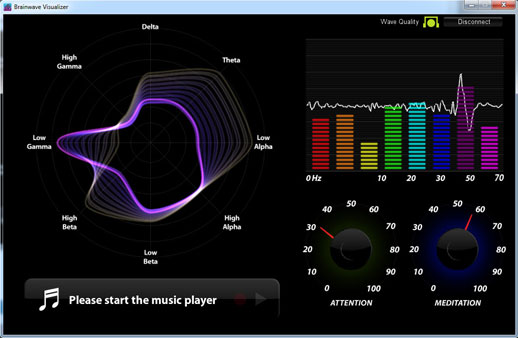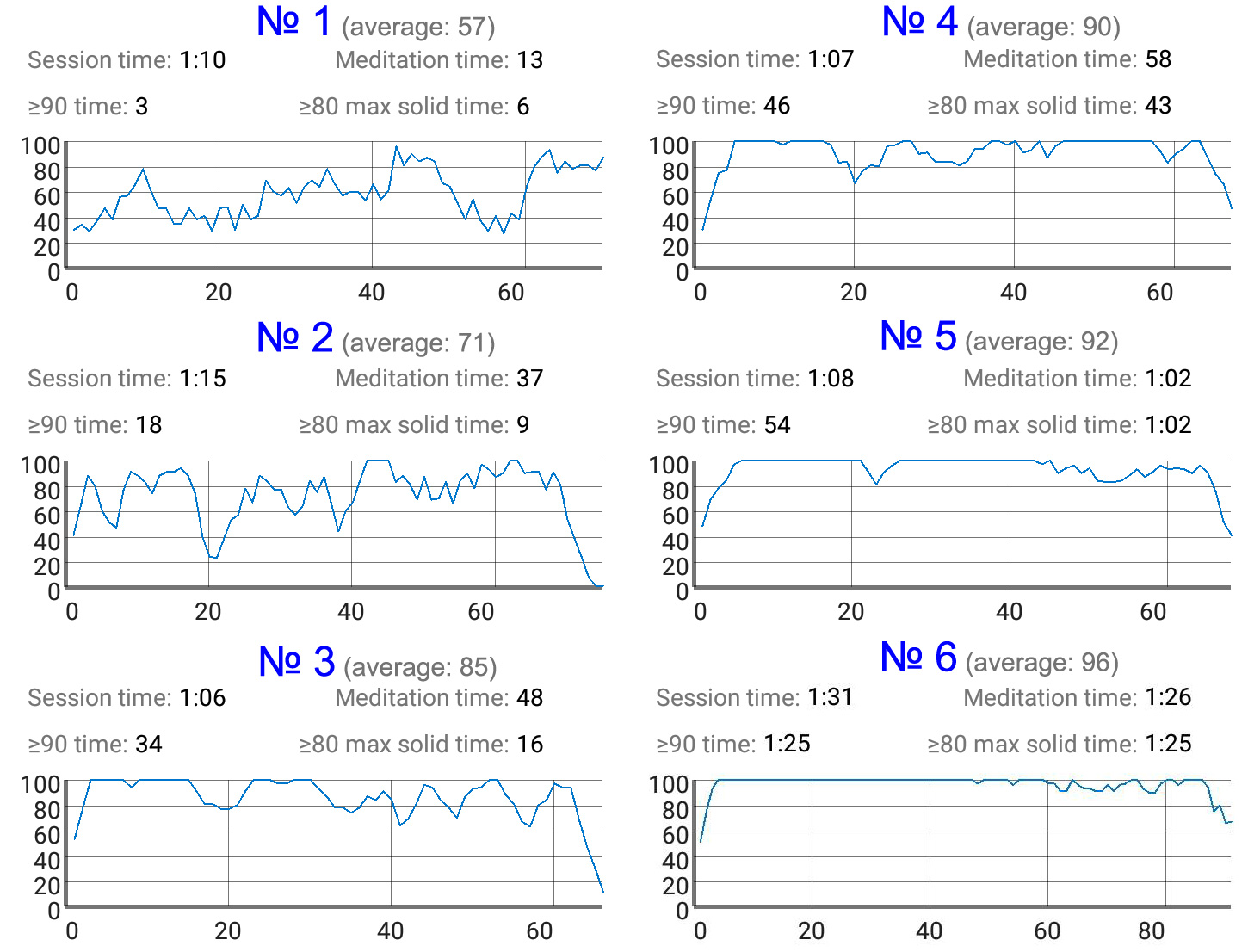Meditation with biofeedback using NeuroSky MindWave Mobile electroencephalograph gadget,
or accelerated self-study of meditation

| |
Question: Rinpoche, is it essential to have a teacher to practice meditation?
Samdhong Rinpoche: Yes! One should have a good knowledge of meditation technique. That may be acquired from a teacher or that may be acquired from a book, or that may be acquired by one's own experiments. One should have a basic knowledge of it. And then if you could have a good teacher, that would be better for the beginners. For the advanced people, then, of course, one should go by oneself. But for the beginners, if guide is there, that would be better, but guide is not indispensable – if you are intelligent enough, and you are mindful enough, then you can meditate without any teacher or guidance, that is possible.
|
This article is about the general questions of EEG meditation and various applications for NeuroSky headsets.
The free 'EEG Meditation' app for Android is described in this article.
The free 'EEG Meditation' app for iOS is described in this article.
The free 'EEG Meditation' app for Windows is described in this article.
Before talking about meditation using biofeedback with a simple one-channel gadget-electroencephalograph Neurosky Mindwave Mobile, we need a small excursus into the history of yoga. This will indicate the scope of this gadget.
In our time, there have already been dozens of types of yoga (if not hundreds). Until the 14th century, in fact, there was only one authoritative text on yoga — the "Yoga Sutras" of Patanjali. None of the varieties of yoga, except meditation and samadhi as its goal, it does not say. And samadhi is itself a means for subsequent purposes. About asanas it is only said that the pose for meditation should be ‘stable and comfortable’. The lotus position looks beautiful, but one of its main uses is rather utilitarian — to prevent the possibility to fall sharply to the meditator and, accordingly, not to get injured if the meditator loses control over the body due to going to samadhi or, much more likely, dozed off during the exercise. And it is necessary to take into account the fact that in ancient India most people did not have chairs and, especially, armchairs.
Since time immemorial, there have been many schools and individual gurus who, with the help of their techniques, taught the attainment of higher states of consciousness through meditation. In ancient times yoga meant meditation, that was achieved through initial exercises in concentration. This tradition, of course, required a teacher.
The guru was needed for a variety of reasons. He acted as a mentor, teaching, in addition to meditation techniques, mandatory moral precepts to the disciple (yama and niyama), that formed the foundation of his future achievements. Thanks to the guru, among other things, the student was kept from the moral fall, which with the help of practices that strengthened any actions could in the end be very, very deep.
Also, the clairvoyant guru could keep track of the current state of the pupil's mind while mastering the techniques of meditation and guide practices of the pupil in the right direction with his advice. This is one of the reasons why it is believed that real success in yoga (that is, meditation) is impossible without a guru. But in our time to help in this particular aspect comes into sight, albeit very limited, the ability to monitor the state of mind using an electroencephalogram showing the rhythms of the brain.
Normal meditation is characterized by high alpha-rhythm (with a frequency of 8-14 Hz), and to some extent gamma (from 30-40 Hz and higher), combined with a low beta-waves (14-30 Hz), that corresponding for thinking "noisy" bustling mind.
The author of this article has crisscrossed half of India for 8 years, published more than 20,000 photos, lived in dozens of ashrams, communicated with several saints & wonder-workers, hundreds of monks, and saw thousands of stray sadhus pretending to be saints and connoisseurs of meditation and samadhi. I participated in hundreds of rituals, pujas, yajnas and other authentic and sometimes highly theatrical performances. All this was exotic, but could not satisfy my aspiration to learn the real shortest path of self-realization. I've read in scriptures, that meditation is higher than any rituals and mantras. I've realized, that only continuous practice of meditation can really give a chance to self-realization.
Earlier, the ability to track brain rhythms was only available with the use of bulky medical electroencephalographs, and their technical imperfection also required the application of a gel (to reduce the electrical resistance between the skin and the electrode) on the head, which after the electroencephalogram recording session had to be washed off. And even with all these uneasy requirements, the quality of the EEG received was not always high, and the old medical electroencephalographs gave out only the "raw" EEG, for deciphering which the doctor needed special long-term training. At the same time, the rhythms of the brain and their significance from the point of view of medicine were also ambiguous and not always well studied, especially in the context of meditative practices.
In our time, microelectronics has made another qualitative leap, and in recent years a large number of ready-made devices or almost ready sets have appeared on the market, allowing not only to receive EEG at home but also to show the rhythms of the brain in real time. This allowed us to provide a biofeedback for tracking the state of the brain (and the mind that is directly connected to it) during activity of various kinds — from the development of attention in restless children to the training of meditation for adults.
Perhaps the very first of such devices was the Mindball, which appeared in 2003 for $ 20,000, the main advantage of which was in a relatively mass demonstration of the very possibility of a non-medical neural interface with biofeedback. Subsequently, amateur enthusiastic projects began to appear, aiming the creation of a cheap household electroencephalograph.
Their main difference was the maximally possible simplified and cheaper construction and, as a consequence, a small number of channels and electrodes. If dozens of electrodes are needed for medical purposes to detect possible problem areas of the patient's brain, then there are enough 1-2 channels (2-4 electrodes) for the adepts of EEG meditation and neural interfaces, since in most cases most of the electrodes produce similar or even almost identical rhythms.
The author of these lines in 2011 collected with the help of two finished electronic boards (ordered in the Bulgarian company Olimex) an amateur electroencephalograph of the OpenEEG project. At that time Olimex did not yet make a practically finished EEG-SMT device and ready-made electrodes for it, and it took a certain amount of radio amateur efforts to make these two boards work.
The passive electrodes of the OpenEEG project showed very poor and unstable signal quality and required a "gel", the active ones had to be made, but with them the signal quality often left much to be desired. And this is not counting some technical nuances. Even now, Olimex, already providing a ready-made device EEG-SMT and ready-made electrodes to it, requires from buyer to provide a "cap" or other options for attaching the electrodes to the head.
Against the backdrop of all amateur and other not very successful developments in recent years, the actual leader in the segment of biofeedback devices now is the finished product of NeuroSky — the single-channel electroencephalograph NeuroSky MindWave Mobile, which can be purchased as part of the Brainwave Starter Kit for about $ 100 (excluding postage costs). This device really shows the rhythms of the brain quite accurately. Here you can read about the comparison of the Neurosky headset with the professional electroencephalograph Biopac system. In addition, the author of this article wore two Neurosky headsets connected to two separate computers at once, and the repeatability of rhythms and values was about 90-95% (it should be noted that there could not be an ideal coincidence of the signals, since they were read though from a closely located, but still different parts of the head).
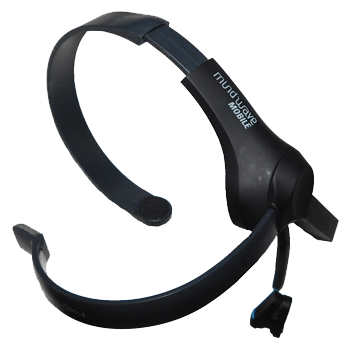 The signal is quite well cleaned by hardware and firmware (inside the specialized chip on the TGAM board module, developed by NeuroSky) from interference of various kinds, including those generated by the movement of muscles and radio interference from the 50/60 Hz household network. It can be concluded tentatively that the displayed data as a whole can be trusted in 80-90%, but this coefficient is very approximate, and it depends on many conditions. Nevertheless, for such a device this is a very good value, even against the background of specialized modern medical neural equipment, taking into account the peculiarities of its application in different countries.
The signal is quite well cleaned by hardware and firmware (inside the specialized chip on the TGAM board module, developed by NeuroSky) from interference of various kinds, including those generated by the movement of muscles and radio interference from the 50/60 Hz household network. It can be concluded tentatively that the displayed data as a whole can be trusted in 80-90%, but this coefficient is very approximate, and it depends on many conditions. Nevertheless, for such a device this is a very good value, even against the background of specialized modern medical neural equipment, taking into account the peculiarities of its application in different countries.
It should be noted that the amplitude, for example, of alpha waves usually lies in the range of 30-70 µV (0.000 030 – 0.000 070 V) on the scalp (and about 10-20 mV inside the brain itself), while the electrical signals from the contracted muscles (including eye blinking and facial expressions) can reach 5 mV (0.005 V) with average values of about 200 µV. Even more interferences from the AC and third-party electrical equipment are offset primarily by solutions of the input circuits of the electroencephalograph, as well as further processing of the signal.
NeuroSky MindWave Mobile is a completely finished product that requires only a Bluetooth interface from a computer or smartphone, to which the gadget transmits its data. You do not have to solder anything yourself, you will not have to sew a cap to fasten the electrodes, you will not need to buy and apply a gel to improve the contact of the electrodes with the scalp. Although the company also sells separate modules that serve as the source of various neural startups.
The NeuroSky MindWave Mobile single-channel electroencephalograph uses one "dry" electrode on the forehead (Fp1 point) and a clip for attaching a pair of reference electrodes on the lobe of the left ear (point A1). The upper arch serves simply to mechanically mount the gadget on the head, there is no electrode at its end. One 1.5 V AAA battery is used in the device, it works with a similar rechargeable battery. With an alkaline battery, up to 8 hours of continuous operation is provided.
Programs and applications are available for PC, Mac, iOS and Android. Also there is amateur development — an application for Ubuntu Linux (link to the video, there is a link to the source code). The old and cheaper version of the NeuroSky MindWave gadget (which is not Mobile) differs only in the absence of a Bluetooth interface and a white colored gadget, the data is transmitted over the radio waves to its own USB transceiver for the computer, and this device will not work with the smart phone. Regarding the quality of the processing of brain rhythm signals, both devices are identical (they can differ only in the year of manufacture with different versions of the TGAT1-L64 microchip and design features, with the latest version of the chip being used for both devices).
Overview of the 'Brainwave Visualizer' application
All the different sets (boxes) sold by NeuroSky, that include this gadget called MindWave Mobile EEG headset, differ only in software and, accordingly, the price. In terms of learning meditation, additional paid entertaining programs are not necessary, since one of the most useful programs in this regard comes with all the kits, including the above-mentioned basic Brainwave Starter Kit. This program is Brainwave Visualizer, which also includes a useful built-in ‘Float’ game.
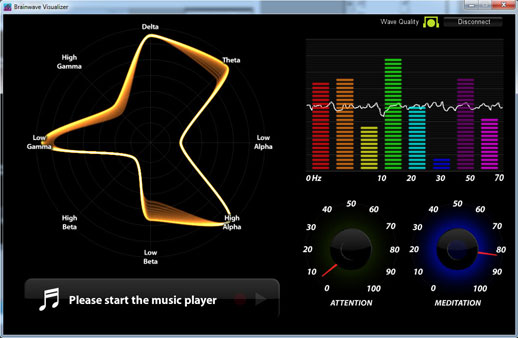
|
Brainwave Visualizer shows in real time (with 1-2 seconds delay) the rhythms of the brain, the white line of the classic EEG over the rhythm diagram, as well as the ATTENTION and MEDITATION meters similar to voltmeters or speedometers with a range of values from 0 to 100. The quality of the headset's contact with the skin is displayed in the upper right corner of the application with the Wave Quality icon, but it can also be checked by blinking the eyes. In case of sudden blinking, there should be a strong splash of the white line of the "raw" EEG over the rhythm diagram. In the below picture, this splash lies above the "50 Hz" value of the dark-violet part of the low-frequency gamma-wave spectrum.
When you move the mouse pointer over the window of this PC program, three white icons appear in its center, and if you click on the right one, called Game, a game is started in which it is necessary to "burn" the barrel through causing intense attention.
White button icons that appear when the pointer of the mouse moves over the application window
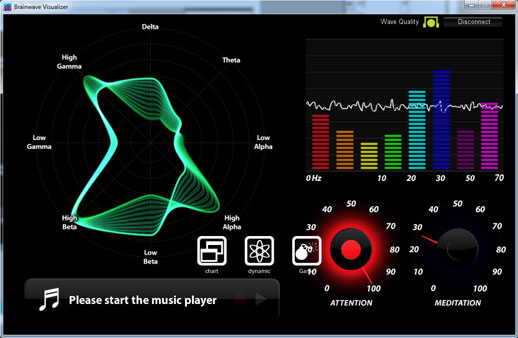
|
Burning a barrel through increased attention
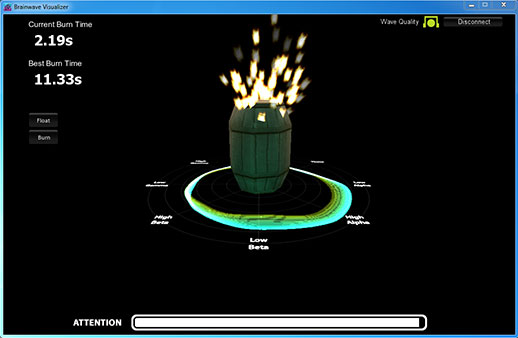
|
If in this game you press the Float button on the left side of the application window, you will get into a game in which, by holding the meditation state, you need ‘to raise as high as possible’ and keep the float ball in the ‘air’ for as long as possible. This game is quite suitable for training the state of meditation with both open and closed eyes. When the ball is lifted above the ‘surface’, a quiet rumbling of a virtual ‘anti-gravity’ engine is heard, and the maximum time for the ball to hang above the ground and the maximum elevation of the ball is displayed on the screen.
In order for the ball to begin to break away from the surface, a meditation level of 2/3 of the maximum value of the white stripe is needed, and for start it to rise you need at least 71-72% of the maximum. At the maximum value of the level of meditation, the speed of lifting the ball is about 1 m/s. When the level of meditation falls, the ball falls down. After getting about 68.5 meters, his ascent is almost suspended. At the end of the climb, the maximum value of current meditation is required to reach the maximum height. The maximum height is 68.71. When you click the white icons "chart" (main application window) or "dynamic" (the rhythm pie chart in the entire application window), the "Best Float Time" and "Best Float Height" in the application are reset.
Circular rhythm diagram "dynamic"
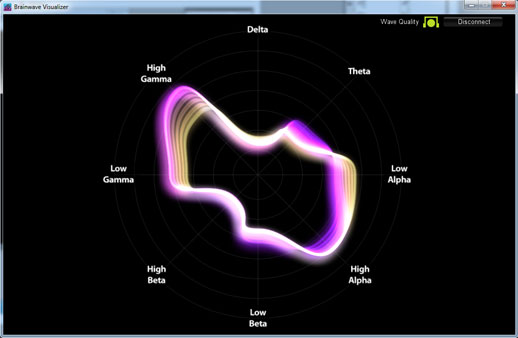
|
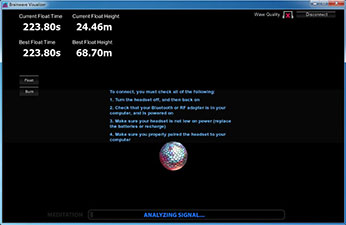 Since the screenshots and videos using this application found on the Internet show not so much the height of the ball raising and the corresponding short time (1, 2, 3, 4, 5, 6), from the below picture-examples you can see that the device itself is able to track the ball raising by more than 68 "meters" and holding it in the "air" for more than 10 minutes. So the limitations are not in the device, but in the meditator. Although in one of the first exercises at the most inopportune moment the battery of the gadget was discharged :) When the battery is discharged, the unblinking blue color of the signal on the connected gadget changes to a double flashing red.
Since the screenshots and videos using this application found on the Internet show not so much the height of the ball raising and the corresponding short time (1, 2, 3, 4, 5, 6), from the below picture-examples you can see that the device itself is able to track the ball raising by more than 68 "meters" and holding it in the "air" for more than 10 minutes. So the limitations are not in the device, but in the meditator. Although in one of the first exercises at the most inopportune moment the battery of the gadget was discharged :) When the battery is discharged, the unblinking blue color of the signal on the connected gadget changes to a double flashing red.
Do not despair if at first there will be no noticeable progress. Practice, and in time everything can turn out. If, of course, you will practice regularly and rightly.
Raising the float ball to the high altitude
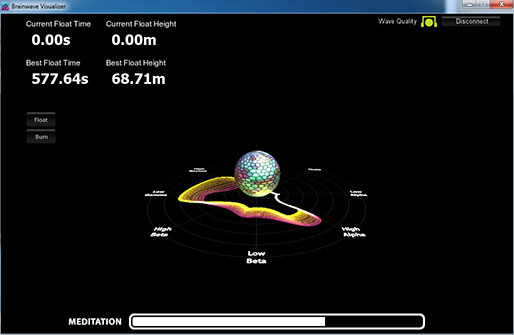
|
Hold the float ball in the air for a while
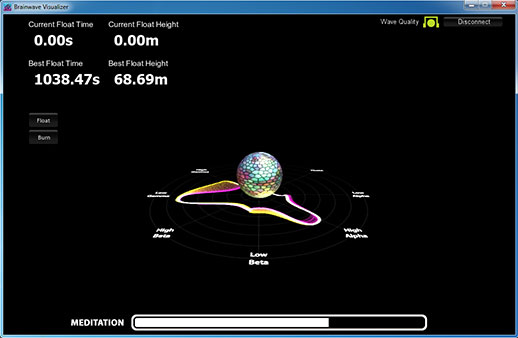
|
Exercise for high-speed lifting and lowering of the ball when the device is turned on
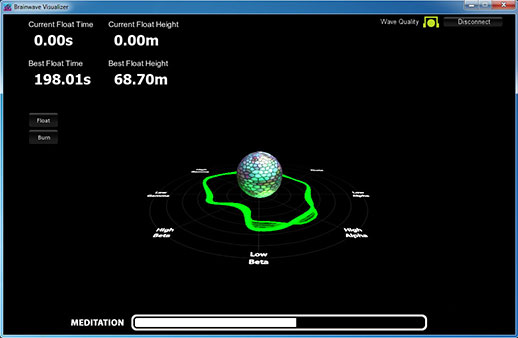
|
the main application window, when the 'Esc' button is pressed on the keyboard, an additional menu, appears, in which you can go back to the application (Back to Game), see the application version (1132 in the example), select the application language (English, Japanese, simplified Chinese, traditional Chinese or Korean), select the "raw" data of the headset in the upper left corner ("speedometers" show data with "averaged" values and delay), axes of rhythms (Show axes, example without axes), go to full screen mode (Enable full screen mode) and exit the application (Quit). When you exit the application and then log in, only the full-screen mode selection is remembered. You can exit the application in full-screen mode by Alt-F4 or through a sequence of Esc and Quit.
Attention! If, after one or two weeks (or sooner) of daily use, the headset suddenly began to lose the signal (at a time when you did not make sudden movements and the battery was not discharged), and the icon "Wave Quality" spontaneously changes from a green circle to orange dots  (three or less) or at all in red x ("no connection"), or the values of "meditation", "attention" and individual waves of the spectrum "hang" and do not change for 5-10 seconds , and the curve of the "raw" EEG began to resemble what is shown in the screenshots below, it means that it is necessary to wipe with the medical nonwoven alcohol disinfection cotton pad for injection the contaminated metal sensor contacts (which touch the forehead — this electrode becomes contaminated fastest, and two on the ear clip) and the skin at the contact points of all three sensors (on the forehead and left ear lobe on both sides). Also for checking the possible improvement in EEG quality, try to move away for 2-3 meters from radio electronic devices with electromagnetic interference, such as laptop power supplies, computers, etc.
(three or less) or at all in red x ("no connection"), or the values of "meditation", "attention" and individual waves of the spectrum "hang" and do not change for 5-10 seconds , and the curve of the "raw" EEG began to resemble what is shown in the screenshots below, it means that it is necessary to wipe with the medical nonwoven alcohol disinfection cotton pad for injection the contaminated metal sensor contacts (which touch the forehead — this electrode becomes contaminated fastest, and two on the ear clip) and the skin at the contact points of all three sensors (on the forehead and left ear lobe on both sides). Also for checking the possible improvement in EEG quality, try to move away for 2-3 meters from radio electronic devices with electromagnetic interference, such as laptop power supplies, computers, etc.
In case if you started regularly encounter the above-mentioned problems of signal quality, you do not have to try every time to search for a long time on the forehead the sufficiently good signal quality, as shown in some videos on Youtube. It is enough, as mentioned above, to wipe the metal surface of three sensors (and, if necessary, the skin in the corresponding places) with a medical alcohol pad for injection.
Example of an application screen with a contaminated electrode surface
(wipe the electrodes with alcohol wipe)
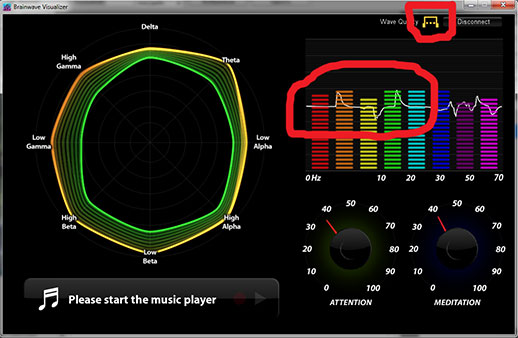
|
Example of an application screen in the presence of strong electromagnetic interference
and / or the contaminated surface of the electrodes (and / or skin)
(wipe the electrodes and skin and move away for 2-3 meters from radio electronic devices,
especially power supplies, until the appearance of such a signal of a white curve)
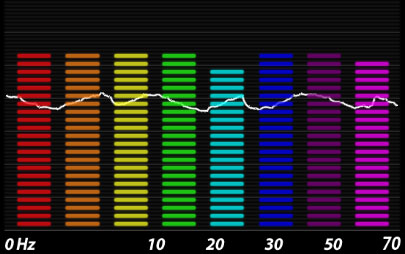
|
It should also be noted that the range of "good" signal quality with a yellowish-greenish circle (with color #B9DD26, similar to the pear-green) of the headset actually has a wide range of values. After a few days of using the headset, the signal quality icon can still be displayed as the above-mentioned maximum, but the signal can already be significantly unreliable in comparison to the maximum possible quality with the clean surfaces of the headset sensors and skin in contact with them. The actual signal quality can be estimated from the shape of the white curve of the Brainwave Visualizer application. If the curve is rough and doesn’t react to your blinking with splash, then it's time to gently clean the surface of the three electrodes and skin at the points of contact with a medical pad for injections. Otherwise, the headset data can’t be trusted as much as with clean electrodes and skin. The data can periodically "hang" for a few seconds and significantly don't correspond to the current state of brain wave activity.

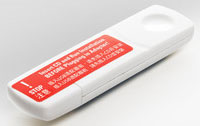 If you purchased a cheaper Neurosky Mindwave white headset (not Mobile, but a microchip, TGAM module and the quality of brain signal processing are exactly the same), then it also has one nuance that can lead to poor signal quality and periodic loss of connection even with clean surfaces of electrodes.
This can happen if you inserted the USB headset transceiver into the computer when installing the device software on the computer before it was asked by the installation program during installation, ignoring the inscription on the red paper, glued to the transceiver and fixing the cap to the brand new MindWave RF Dongle. In this case, the operating system could install first its own COM-port driver "USB-SERIAL CH340", and it must be replaced with the driver "MindWave USB Adapter". The process of reinstallation is described in detail here.
If you purchased a cheaper Neurosky Mindwave white headset (not Mobile, but a microchip, TGAM module and the quality of brain signal processing are exactly the same), then it also has one nuance that can lead to poor signal quality and periodic loss of connection even with clean surfaces of electrodes.
This can happen if you inserted the USB headset transceiver into the computer when installing the device software on the computer before it was asked by the installation program during installation, ignoring the inscription on the red paper, glued to the transceiver and fixing the cap to the brand new MindWave RF Dongle. In this case, the operating system could install first its own COM-port driver "USB-SERIAL CH340", and it must be replaced with the driver "MindWave USB Adapter". The process of reinstallation is described in detail here.
Screenshots of Brainwave Visualizer application for Android
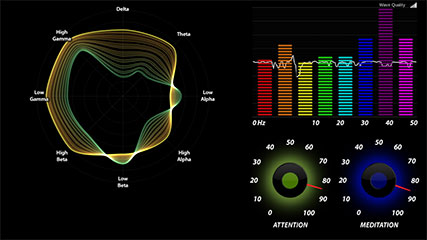
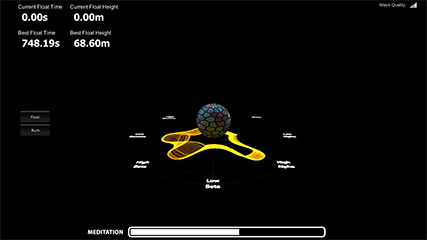
The values of "attention" and "meditation" are calculated by the firmware of the ThinkGear™ ASIC Module (TGAM) inside the device and transmitted by the gadget (in the range of values from 1 to 100; 0 — the value can’t be reliably calculated due to a weak signal) by Bluetooth interface to the computer or smart phone in the finished form along with the current values of each of the individual rhythms (the values of all the listed parameters are formed and transmitted 1 time per second), the ‘raw’ initial signal of the EEG and signals such as ‘blink’ and ‘bad signal quality’. Algorithms for calculating the values of ‘attention’ and ‘meditation’ are not disclosed by NeuroSky. The maximum value of the parameter ‘attention’ is achieved with a variety of combinations of rhythms of the brain, but generally requires a high activity of beta (and to some extent gamma) waves.
High Attention
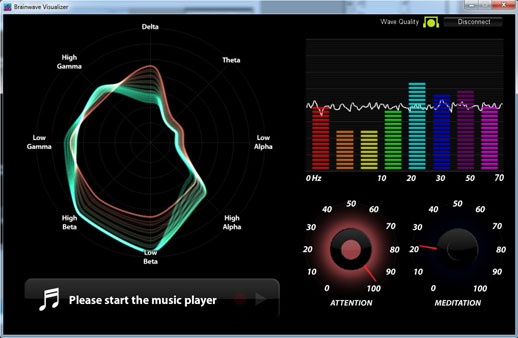
|
From the general statements of the company we can assume that high values of ‘meditation’ requires the domination of the alpha-rhythm (and, possibly, gamma) over the beta-rhythm, taking into account the values of all rhythms in the last few seconds. The secretiveness of the algorithm for calculating ‘meditation’ does not allow you to accurately determine in which proportion what rhythms are more important for calculating this meditation value of the TGAM module (and this value is displayed by the Brainwave Visualizer application), and, accordingly, what exactly will you train in this program. Although, if you really know how to meditate, the Brainwave Visualizer program will in any case show that yes, you are meditating.
High value of meditation
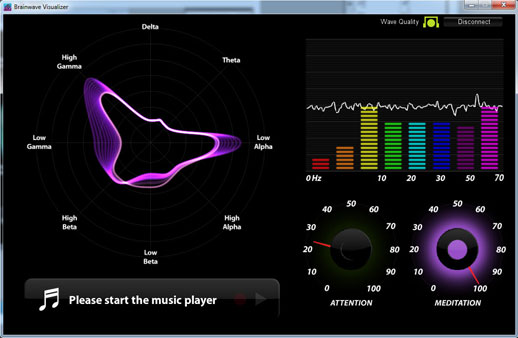
|
If you want to track only the values of ‘meditation’ and ‘attention’, you can use the ‘Meditation Journal’ application. If you want to track individual rhythms, you can do this from the diagram in the main window of the Brainwave Visualizer application. If you want to track certain combinations and ratios of different brain rhythms, and also record them in a file for later playback, then there is an interesting free application NeuroExperimenter for PC. There is also another ‘Home of Attention’ program, which is available in the free 14-day trial version and the full version for $99, which is almost equal to the price of the device itself, short of the cost of delivery. This application generally loses to the rest of the above, but, nevertheless, it is one of those very few applications that may be of interest to meditators. The remaining dozens of applications are written mostly for children and are often built on the principle of ‘solve a simple task and look at the decision time and the diagram (or average value) of the level of attention that was during the solution of the task’.

Also you can download and install my free "EEG Meditation" Android app from Google Play. This app is specially made for meditation practice with NeuroSky MindWave Mobile headset.
The author of this article also checked the influence of binaural beats on practice in real time. Unfortunately or fortunately, different experiments with different records of alpha rhythms, reproduced at different loudness for about 10 minutes each one, showed that they practically do not affect the transition to the state of meditation. The level of alpha rhythms shown by the application of the headset depended almost exclusively on conscious transition to the state of meditation, and not on listening to binaural alpha beats in headphones. A trained mind can enter the state of meditation in a couple of seconds, which is incredibly more effective than any binaural beats. Perhaps, they can help someone, but, in any case, this is not the key help. You will have to overcome anxiety and distraction of the mind yourself.
It should also be noted that the described headset is not physically able to read the thoughts, it can only demonstrate the absence of thoughts or, on the contrary, the presence of any thought or simply focused attention. In this case, only the general degree of concentration and excitation of the mind (‘attention’) is registered, and not the variant of coloring it with this or that thought. All that this headset can display is the rhythms of the brain at one point (by default it is Fp1) and the values of meditation and attention formed on their basis. Baloney, shown in one video, may have been aimed at popularizing the gadget in any way, but the inevitable subsequent disappointment after a detailed review of the headset in general produces a rather negative profaning effect. The task of reading thoughts in a technical way is still unresolved, and some partial relative success requires, first of all, a professional electroencephalograph with dozens of invasive sensors, as well as an analyzing computer system with AI and a large observational database collected in the course of long pre-training. Not to mention the fact that such studies are not conducted "by hands". And even such a complex system can still make mistakes in "reading" thoughts, because it will capture the expected characteristic combinations of the "spectrum" of electrical impulses in different parts of the brain, and not the thoughts themselves.
From the point of view of studying meditation, the headset can be used in two main ways, and in this connection all thematic applications can be divided into 2 main groups.
The first way is to evaluate your ability to meditate. For this you can use any applications listed in this article, including the game "Float" of application Brainwave Visualizer. In this game, when the ball is initially raised to a high altitude, a significant delay between the exit from the state of meditation with the eyes closed and the sound indication (disappearance of the "rumbling") of the application about an exit (even complete and prolonged) from the state of meditation is possible. This delay can be as long as one minute, or even more. Accordingly, such applications have a limited opportunity to aid in the study of meditation due to a significant delay in biofeedback, and they can serve basically only as indicators of your ability to meditate, which you can use from time to time in conjunction with meditation practice – with headset or without. This is not the most effective way to use the headset.
The second way is actually help in the study of meditation. For this purpose, such applications are suitable that, when exiting the meditation state, make an audible signal every time as quickly as possible taking into account the technical limitations of the headset – in 1-2 seconds, providing quick biofeedback, and by this speeding up the study of meditation. Such a sound signal immediately informs that meditator has left the state of meditation and helps react faster, immediately prompting meditator to try to return to the state of meditation, rather than sit for a whole minute in thinking on how best to meditate.
Unavailable publicly internal algorithms for the acquisition of an every second value of "meditation" parameter are executed by the firmware of the ThinkGear ASIC Module (TGAM) inside the headset, and explicitly take into account the data for the last few seconds (and not only for the last second), and require a sufficient number of oscillations of low-frequency signals for reliable calculation of the frequency spectrum using a fast Fourier transform.
In algorithms for calculating the parameter of "meditation", not only the alpha-rhythm (its high value clearly indicates the state of meditation) is taken into account with a frequency of 8-13 oscillations per second (which can be reliably calculated every second, and in theory and with insufficient reliability even in 1/8 seconds), but also the ratio of its amplitude to the amplitudes of other rhythms, including theta rhythm (4-8 oscillations per second) and delta rhythm (4 or less oscillations per second). From the point of view of pure mathematics, for a more accurate calculation of the amplitude of such low-frequency rhythms, a sufficiently long time interval of the signal is required. For these reasons, the headset can give out a sufficiently accurate value of the "meditation" parameter only once per second or less often. And this value is formed according to the results of the already passed last second, and, in addition, taking into account the values of the rhythms for the previous seconds.
The meaning of the above paragraph is that the delay of the "meditation" parameter generated by the headset is 1-2 seconds compared to the actual state of the mind of the meditator, and this time can’t be less at the current technological level and the approach to reading the EEG. Nevertheless, this is a good result, which is quite suitable for providing effective biofeedback. Perhaps in the future there will be another technological leap, and reading a more reliable magnetoencephalogram (MEG) or using an even more sophisticated way of determining brain and mind activity will become as affordable in everyday life as reading EEG with modern headsets.
Among the free applications that are well suited for the second way of using the headset are ‘NeuroExperimenter’ for IBM PC and ‘EEG Meditation’ for Android. These applications are specifically written for accelerated self-study of meditation, providing quick bio-feedback with the Neurosky Mindwave Mobile headset.
It is also necessary to take into account the fact that the state of meditation is specific in that it is disturbed by any thought or distraction of the mind to "digest" the semantic information. Because of this, the sound signal, informing about the exit from the state of meditation, should be as much as possible "neutral" and not giving semantic food for the mind.
The best examples of such neutral sounds include the "rumbling" of the game "Float" of the Brainwave Visualizer application and the so-called white noise. Unfortunately, "rumbling" is almost impossible to implement on the Android platform (with its SoundPool and MediaPlayer sound capabilities) so that it has a smooth rise and fall in the sound volume for one second with an every second update of the level of meditation, and also to make that no clicks were heard, even if you stretch the sound for a second second, regardless of the level of meditation in this second second. In the game "Float" you can hear a disturbing click every 7 seconds, especially on a smartphone or other device with a weak low-frequency component of the spectrum of the played audio signal. Smooth rise and fall of the sound volume in the game "Float" is achieved due to the blurring of the time interval of actual meditation and the forced extension of its duration by several additional seconds.
What exactly do you get by using the NeuroSky MindWave? You will immediately know if you really can meditate, and how much you can. You will find out if your studies in yoga studios (if any) were just fitness, or they gave you something more. In addition, you can track the loss of the state of meditation ("drowning" the mind or other reasons), for example, in 5-30 minutes after its successful start, even if it seems to you that you are still meditating. Also, you can in practice check the effect of much or heavy food on the current ability of the mind to meditate and understand why most meditators tend to a vegetarian or even vegan diet. Just as you can also track the impact of various events on your meditation.
It should be noted that different methods of meditation involve different combinations of rhythms of the brain. Neurologist Dr. Fred Travis (PhD) explains that from the point of view of the rhythms of the brain, meditations can be divided into three categories: focused attention, open monitoring and automatic self-transcending (here he means Maharishi's transcendental meditation). Different types of meditation have different techniques and have a different picture of EEG. They activate different areas of the brain and therefore have different advantages; a review on YouTube is here.
In addition, one of the different forms of Buddhist meditation is associated with an increase in gamma activity and is not associated with an increase in alpha activity, and the value of meditation calculated by the gadget itself may even decrease during such meditation compared to the ordinary state of mind. More in the article about the experience of "Sally" is here, p.3. In addition, Sally says: "There is more to meditation than producing certain brainwaves. You must learn the internal and external cues that warn you of loss of focus. This headset might be useful to signal that your mind is wandering, but is no substitute for hard work and continual practice. Eventually, you will have to depend on yourself. There are many books, videos, and instructors available to guide you".
In the above article in English it is said that "Sally" was trained in meditation by experts and daily meditates for more than 20 years. At the same time, the level of "meditation", which is most influenced by alpha-wave activity, showed that during meditation of "Sally" her "meditation" indicator for 18 minutes averaged 0.85 from the value of "meditation" in the previous 17 minutes , when she read a book outside the meditative state, browsed the sites on the Internet and ate a little. At the same time, during 18 minutes of meditation, the activity of gamma waves increased almost 2-fold, and the delta-wave activity almost halved. These are the features of that meditation (relating to one of the varieties of Buddhism), which "Sally" learned more than 20 years ago and practiced all this time.
If you see that your case is similar to the rare case of "Sally" — that is, you are sure that you can meditate, but the indicator of "meditation" and the float ball try to convince you of the opposite, pay attention to the gamma-rhythms in your meditation. If they increase significantly, then the NeuroExperimenter program will be useful to you. If your meditation, like for the majority of meditators, including Maharishi TM, is accompanied by an increase in alpha waves, you can use the Meditation Journal program, which has been bundled with the Mindwave headset in recent years as part of 10 free applications on the installation disc, as well as a separate free application Brainwave Visualizer.
What can you get with the use of NeuroSky MindWave? You have the opportunity to train your attention and chance to learn the basics of meditation. If you, like many other people, have never before been interested in the techniques of controlling your consciousness, it may well be that you simply can’t consciously and steadily evoke the high and long values of meditation. The arrow of the meditation meter will usually jerk randomly, and you will not understand how it can be controlled at all.
Then you, perhaps, can get more help from a competent teacher of yoga studio or class of meditation, than from this gadget. The abstract book words "you just need to relax", "take away the mental tension", "close your eyes", and "stop the internal monologue" do not convey those states of meditation that you need to consciously "evoke" and which you need to achieve for further development in meditation using devices, similar to gadget NeuroSky MindWave Mobile. Although some people can "catch" the state of meditation in just a few hours of practice with a gadget. One of the key points of the dominant alpha waves — you should not even try to come up with a further topic for your thoughts. It is necessary to maintain such a fixed and steady mind as possible.
In addition, the very ability to meditate steadily comes only with time — this is the result of a long training of the mind and consistent practice. For example, in colleges where teachers assess students only for their knowledge (without bribes and etc.), the mind develops concentration, attention and analytical skills for 5-6 years with various " further mathematics", “strength of materials” (also called “mechanics of materials”) and other intense studies at the university in order to get a strong intellectual worker (intellectual). Most formulas and tables to the time of graduation will be forgotten, but trained for years (less will not work) the mind will remain. Similarly, in the gym all the dumbbells are still in the same place after years of training, but the muscles of the trainee become stronger.
If you are such a competent meditator that you can keep the predominant alpha rhythm at least tens of minutes, then such a device is no longer necessary for you. However, the likelihood that such a meditator will read this article is just as small as his need for such a device :)
In addition, prolonged retention of the predominant alpha rhythm, or gamma rhythm, or conscious mind without thoughts is three different things. Although they are correlated to some extent among themselves, they are still not identical. Especially the retention of the predominant gamma-rhythm and thoughtlessness. In addition, a breach of thoughtlessness can be a "loud" thought or unobtrusive, which, in the latter case, still partially hinders the increase of the kundalini stream (even if it's the most insignificant and requiring hundreds of years for a tangible effect), as well as further raising the ball in the Brainwave Visualizer can prevent even a small thought, distraction or anxiety;) About the levels of refinement of the "activity" of the mind you can, for example, read about Vaikhari and Madhyama in Robert Svoboda’s “Aghora II: Kundalini”. Also from the point of view of the requirements for meditation, this commentary of an experienced Buddhist monk is indicative:
|
Question: Will those people who have achieved the power to concentrate for hours at a time attain the powers known as the siddhis?
Answer: A person who has advanced so far as to meditate for three hours at a time is certainly no longer an 'ordinary' person. But the siddhis will only come after shamatha has been achieved and the mind is absolutely quiet. (In other words, it should be 3 hours of continuous real meditation without a single thought, and not its external imitation in the style of the Cargo cult.)
|
It should also be noted the psychological moment — the purchase of a gadget, which is much more expensive than a yoga mat, can discipline you and force to make regular practice of meditation (or purposefully try to learn its techniques). This is a definite stimulating moment that can accelerate your evolutionary growth.
What exactly you can’t get with this gadget? You will not be able to monitor the coherence of brain activity. The reason for this is simple — in this device there is only one pair of electrodes, and also the third "ground" electrode. The active electrode is located on the forehead at the point Fp1, and the 2 electrodes on the ear clip are the reference (twin) electrode for the first and the "ground". Nevertheless, if you learn to keep the prevailing alpha and gamma rhythms for a long time, the coherence of brain activity will necessarily grow.
In addition, you should not be deceived that with the purchase of this device your progress in meditation will necessarily go by leaps and bounds. Yes, the biofeedback provides an opportunity to accelerate progress in the mastery of meditation. On the other hand, most of the sensations in meditation and its very quality are easily tracked by the very mind of the meditator. It's just that you'll see changes in the rhythm diagram of the brain or in meditation level a little earlier than you notice that you started thinking again and generally left the state of meditation.
To think that with the help of NeuroSky MindWave Mobile you will become tomorrow a master of meditation is the same as to believe that by buying a guitar, you will start playing it tomorrow as Jimi Hendrix or Mark Knopfler. In the question of development of the mind this gadget can be compared to collapsible dumbbells for the development of the physical body. If you just look at dumbbells every day, touch them and watch videos on Youtube about how to do best exercises with dumbbells, how others do these exercises and discuss these exercises with friends, there will be no progress. And even if you spend a month or two training every day, you too will not notice much progress. In both cases, at least a few years of training is required to achieve a tangible result. But, unlike a physical body, consciousness has no limitations for its development.
One must realize that real progress in meditation is possible only with strong personal motivation and the regular practice, and that in the past people have achieved this progress without any gadgets and headsets. The device NeuroSky MindWave Mobile can help in your study of meditation and personal (spiritual, evolutionary) growth, but, ultimately, it depends entirely on you.
In addition, such a gadget is a kind of a dangerous force that allows you to accelerate your evolutionary development and increase your mental strength, but without moral self-control it can lead to a fall even deeper than without it. A gadget is not a guru who can stop you from the moral fall through temptation by force. The ability to accelerate the study of meditation with this headset carries this risk, demanding a serious moral self-control.
Also worth noting is another feature of the gadget. After you have tracked this or that state of meditation with its help, started to feel these states and in some time learned how to call them at will, you can successfully meditate without this gadget. Of course, you can continue to meditate with it, but in fact it will no longer be a permanent necessity. But, nevertheless, such meditators can get help from the headset to track the state of the "drowning" of the mind, in which thoughts are still absent, but the focus of meditation is lost.
In addition, the achievement of deep meditation states (from dhyana and higher to samadhi and shamatha / samatha) will depend entirely on you, while you will no longer be able to rely on the headset values. Algorithms for calculating rhythm values continuously dynamically change the averaged ranges of monitored microvolt values against the background of interference on the EEG spectrum (including muscle tension and ECG), and you can’t rely entirely on the gadget values anymore. Fortunately, if you reach these levels, you can already improve your meditation yourself.
|
The achievement of shamatha is indeed a landmark in meditation. We must not forget however that it is not the ultimate goal, but it is the point from which real meditation starts. Until its achievement we are only training our minds to concentrate without being disturbed by thought, or getting into the sinking condition. Eventually, the serious person perseveres with his meditation for the sake of meditation only and enters into the eight types of samadhi; that is to say the four types of rupa samadhi and the four types of nirupadhi samadhi.
It is a real luxury for the meditator to explore these different grades of samadhi.
|
The following is a recommended sequence for using the headset applications. At first it can be the main window of the Brainwave Visualizer, in which you can achieve the sound of a melody that appears whenever the level of meditation reaches 75% or higher. If you experience difficulties at this initial stage, it is recommended to meditate with your eyes closed.
Then, if you get more or less often to hear this melody, you can go to the game "Float" in the same application, training in raising the ball as high as possible and keeping it in the air for as long as possible. If you can almost every time to raise the ball to 68-odd meters and keep it in the air for 10 minutes or more, you can go to the application NeuroExperimenter (available only for PC). The idea is that in the process of prolonged retention of the ball in the air at high altitude, relatively long periods of ball subsidence are possible because of periodic low values of the meditation level with distractions that will not be tracked during meditation with closed eyes, and the effectiveness of meditation training will not be the best.
If you want to speed up your further study of advanced meditation at this level and prefer to meditate with your eyes closed (although you can raise the ball up to 68 meters with open ones), it is recommended to use the NeuroExperimenter application with reverse sound setting (choose 'audio on' and 'reverse volume' ) and a high value of about 0.7 (or 0.8), as in this example. With these settings at a meditation level of 0.7 or higher, there will be no sound output, and this will not divert your meditation. If the level of meditation is reduced, a sound will appear, the tonality of which will vary in the specified range (in the example from 0.7 to 0.2, below 0.2 tonality will not change) depending on the every second level of your meditation. An example of the application screen during the meditation session with these settings is given here. Note that the red line is drawn at 0.2, but with the sound setting reversed, it determines the beginning of the tone change, not its appearance.
With this exercise, in a couple of seconds you will find out that you are out of meditation, and the process of studying meditation eventually will be faster. If you continue to raise the ball in the Brainwave Visualizer application (with your eyes closed) with this level of meditation, then this can be compared with the widespread ineffective approach to kumbhaka training (breathing retention when performing pranayama in yoga).
In the ancient Indian yogic texts it is written that the breathing delay (within comfortable limits) should be trained on exhalation. Beginners prefer to train it after inhaling, because "so the results are better". But then it turns out that the first half of the exercise you just gradually expend oxygen, which you first inhaled with "full breast," and the training itself begins only after a time when oxygen in the lungs will remain as if exhaled. That is, at first you just waste time, in vain "wasting" the air. If you train the delay on exhalation (as the writings of the ancient yogis recommend), then you immediately begin training. Given that there is usually not much time for yoga exercises, there is no sense to postpone it every time.
Similarly, it is better to use the NeuroExperimenter application with the above parameters instead of lifting the ball by 68 meters and holding it for 10-20 minutes, if these 68 meters are reached in the first 2 minutes, and the rest of the time the ball may be swinging at 10-50 meters when the state of meditation can be lost from time to time. Though the maximum ball holding time in the air indirectly may indicate the maximum duration of your meditation in general, but the important point of training is lost — the sound indication of the periods of loss of the state of meditation.
The author of the free application NeuroExperimenter Fred Mellender wrote in a comment on amazon.com: “I am the author of NeuroExperimenter (free PC software that interfaces with this device). As such I have good acquaintance with the NeuroSky headset. I found it very reliable: the hardware has never failed in my extensive use. Furthermore, it seems accurate . The experiments I have done (documented in the User's Guide for NeuroExperimenter) are repeatable and convincing. The software that comes with NeuroSky is not very functional, however. There is more you can try at the NeuroSky store — some free. I have no connection with the NeuroSky company”.
About the steps of the progress in the practice of shamatha meditation with the NeuroSky headset based on long experience of its use
The image below shows fragments of six screenshots of typical stages of meditation training with the NeuroSky MindWave Mobile 2 headset.
It should be noted right away that the best graphs require a combination of a number of factors – when 3 hours have passed after eating, the absence of too much physical or mental fatigue, the presence of previous moderate physical or mental activity, the relative calmness of the environment recently and silence during meditation. If these factors are not observed, even a good meditator will not be able to demonstrate his maximum level.
The first example shows typical results of a novice with a relatively chaotic graph. At the beginning of the practice of meditation, a novice can consciously influence the "meditation" parameter in the direction of increasing its values by no more than a few percent due to the lack of training of the state of meditation. This is similar to how a beginner hanging on a horizontal bar can only twitch on it, without being able to fully pull himself up. A poor understanding of exactly which mental states corresponds to the state of meditation will also affect, especially considering the approximately 1 or 2 seconds technical delay in the displayed values compared to the state of mind. As a result, the graph will fluctuate almost uncontrollably over the entire range of values, and the 100% level of meditation will last no more than 1-2 seconds. At the beginning of this practice, it makes no sense to try to meditate for 20 minutes in a row or more, since the actual limit in meditation is still no more than a few seconds in a row. It will be much more effective to do 10 sessions per day for 2 minutes than one hour of tortured session, as it were, of meditation.
The second example shows the result, which is quite possible to achieve after a week of daily training at least 10 lessons per day for 1-2 minutes. The chart of the level of meditation is gradually shifting upward, just as a beginner on a horizontal bar is able to try to pull himself higher, even if he still cannot pull himself up even once. The average level of meditation rises (in this example, it is 71).
In the third example, the graph rises more and more, and the average level of meditation rises even more (in this example, it is 85). The total time spent in a state of meditation with a level of more than 90% significantly increases (in this example, 34). The duration of the periods of 100% meditation increases to 5 or more seconds, and such periods occur several times per minute. The duration of the periods of meditation begins to increase markedly, when its level never fell below 80% (in this example, 16 seconds), which roughly corresponds to shamatha meditation.
In the fourth example, the graph as a whole rises even higher, and in general it rarely drops below 70%. Such results require a long preceding training of thoughtlessness. The average level of meditation (in this example, it is 90) and the total time spent in a state of meditation with a level of more than 90% (in this example, 46 seconds out of 67 seconds of the total time of a meditation session) rises even more. Also, the duration of the periods of meditation gradually begins to increase, when its level never fell below 80% (in this example – 43 seconds), but this parameter is very “capricious” and requires a combination of different factors mentioned at the beginning of this section of the article. The duration of the periods of 100% meditation increases even more.
The fifth example shows the result of training, when the level of meditation may not fall once below 80% for a minute or longer. All indicators are improving. Such results are usually achievable within a couple of months of daily training 10-20 times a day for 2-3 minutes, although a lot depends on the initial level, as well as on how the meditator is able to notice various distractions of the mind and easily overcome them at the very initial stage.
The sixth example shows a graph that is quite achievable in several months of training, but requires a combination of different factors mentioned at the beginning of this section of the article. Only individual Buddhist monks, such as Yonge Mingyur Rinpoche, Matthieu Ricard and others, can hold this level of meditation for an hour or longer. For ordinary meditating lay people, the meditation graph, half an hour after it begins, will begin to resemble what is shown in the third or even second example.
Interestingly, within small limits, it is relatively easy to control the values of the "meditation" parameter by forcibly holding the breath for a couple of tens of seconds or by some preparation for the meditation session with the help of certain monotonous actions calming the mind. But such manipulations will not allow you to regularly achieve really long sessions of meditation – from a few minutes or longer. At the same time, the daily practice of shamatha / samadhi meditation with the required intensity - ranging from several dozen sessions for a couple of minutes a day to one multi-hour session, provided that the average level of such meditation is not lower than, for example, 80 – allows over time to achieve relatively easy the multi-minute high-quality meditations, confirmed by a neuroheadset, even if the subjective quality of meditation does not seem to be high. This is due to the fact that meditation is not a talent or even a skill, but – with the regularity of daily exercises – a gradual energy build-up / pumping, which, as a side effect, is accompanied by a strong dominance of the alpha brain rhythm in the state of shamatha / samadhi, which is registered by neuroheadset.
The amount of volitional effort providing a high level of meditation for a long period is quite limited for each meditator. Just as it is impossible to pull up on the horizontal bar today 15 times, if before that there was a maximum of 10, so in meditation, in spite of all its immateriality, there are quite definite volitional and energy limits that are increased very slowly, especially when living in society. These limits are increased by training. But the lack of practice of meditation during every 2-3 days reduces by 2-3 times the current maximum duration of meditation exponentially. The lack of practice of meditation for about a month actually casts the meditator to the very beginning – to almost zero results, although the resumption of practice will lead to a faster improvement in results than a beginner.
After achieving high results of the level of meditation (scientifically confirmed by a neuroheadset) for a couple of minutes, it is necessary to gradually increase the duration of meditation sessions. In Buddhism, the goal of shamatha meditation is to achieve its duration within 3-4 hours without a single thought, distraction of the mind or drowsiness.
This is a translation into English of this article of the author of this site.
Questions and Answers on NeuroSky MindWave Mobile neuroheadset in the context of meditation practice.
The free 'EEG Meditation' app for Android.
The free 'EEG Meditation' app for iOS.
The free 'EEG Meditation' app for Windows PC, for the white or black headsets.
The free Little Buddha: meditation with NeuroSky neuro-headsets app for Android.
The arguments in favor of the use of EEG headsets, such as NeuroSky MindWave Mobile, for meditation.
Comparison of the 5 headsets for meditation: NeuroSky MindWave Mobile, Muse, EMOTIV EPOC+, EMOTIV Insight and Melomind.
What meditation is and how to meditate.

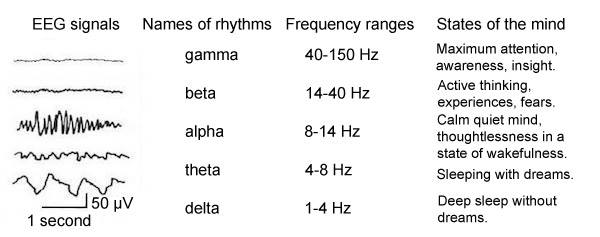
 The signal is quite well cleaned by hardware and firmware (inside the specialized chip on the TGAM board module, developed by NeuroSky) from interference of various kinds, including those generated by the movement of muscles and radio interference from the 50/60 Hz household network. It can be concluded tentatively that the displayed data as a whole can be trusted in 80-90%, but this coefficient is very approximate, and it depends on many conditions. Nevertheless, for such a device this is a very good value, even against the background of specialized modern medical neural equipment, taking into account the peculiarities of its application in different countries.
The signal is quite well cleaned by hardware and firmware (inside the specialized chip on the TGAM board module, developed by NeuroSky) from interference of various kinds, including those generated by the movement of muscles and radio interference from the 50/60 Hz household network. It can be concluded tentatively that the displayed data as a whole can be trusted in 80-90%, but this coefficient is very approximate, and it depends on many conditions. Nevertheless, for such a device this is a very good value, even against the background of specialized modern medical neural equipment, taking into account the peculiarities of its application in different countries.
